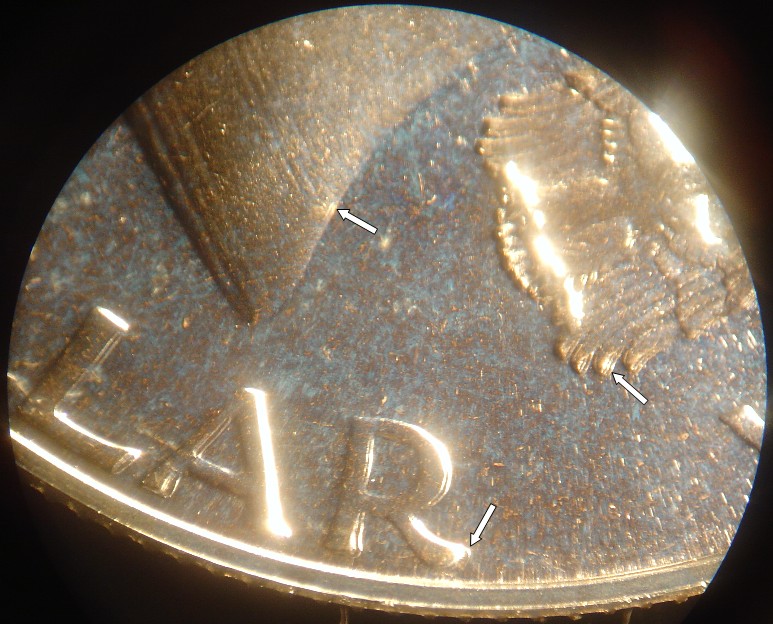Does Anyone Have A Photo Of A 1961 Franklin Half DDR?
I found a 1961 Proof today with doubling on the back and wonder if someone has a photo or photo's of the Doubled Die Reverse/s so I can tell if it's a good one or not. I was able take this photo, but ya probably can't tell a whole lot by it...


0
 Monster Wavy Steps Rule! - 1999, WSDDR-015, 1999P-1DR-003 - 2 known
Monster Wavy Steps Rule! - 1999, WSDDR-015, 1999P-1DR-003 - 2 known
Comments
Greg Hansen, Melbourne, FL Click here for any current EBAY auctions Multiple "Circle of Trust" transactions over 14 years on forum
<< <i>The motto is what I always thought was the pick up point. >>
That's correct - and that is a great image! There are quite a few DDR's for the 1961 proof Frankie, but the big daddy is the one with very visible doubling in the motto.
Russ, NCNE
My EBay Store/Auctions
What is the difference between die doubling and strike doubling?
Thanks
Link to 1950 - 1964 Proof Registry Set
1938 - 1964 Proof Jeffersons w/ Varieties
strike doubling ocurrs when there is movement of the planchet in the collar or shifting of the die in the press and can be over the entire surface of the coin or as specific as just the mint mark. it is as though the die strikes full and then slides to the side slightly, or the planchet shifts, leaving a rounded appearance to the design features affected.
at least that's my understanding, flawed though it may be.
al h.
I'm no expert. I have an educated novices understanding of whats going on. The following appears from the CONECA website:
The hubbing process, while rather simple in its procedure, is rather complex in the varieties that it produces. Once the master die (incused image) is created (a process not completely relevant at this point), it is used to hub or squeeze a working hub (relief image), which is in turn used to hub a working die (incused image). Since one hubbing is not usually enough to bring up a sharp image, the die is annealed (softened by heat) and re-hubbed, occasionally multiple times. If the working hub and working die with its initial image are not fitted together properly in the press, a doubled image occurs on the die. This doubled die will in turn transfer a doubled image to every coin it produces. While much has been made of the way in which a doubled die is produced (the complex part), the important thing is to be able to recognize the characteristics of hub doubling. These characteristics include raised, rounded images with splits in the serifs and valleys or furrows between the images. These are the same characteristics as found on repunched dates and repunched mintmarks. Being able to distinguish hub doubling from “machine damage doubling” (sometimes called “ejection doubling,” “mechanical doubling,” or “strike doubling”) is a mark of the advanced variety collector. However, anyone can learn the difference if they are willing to take the time to study the photos and the coins.
In its infancy, the collecting of hub doubled coins, commonly known as “doubled dies,” centered around the circumstances that produced the various kinds of doubling known. For example, the doubling on some coins appeared all the way around the rim lettering in a clockwise or counter-clockwise fashion. Other coins exhibited doubling on just some of the rim lettering. On other coins, the doubling was directed toward the center or the rim. Still on others the doubling affected only certain design elements. Thus the following classes of hub doubling were proposed, principally by Alan Herbert, to explain these differences. Most hub doubling is now regarded as a hybrid of these classes. It is very difficult with only a coin in hand to logically backtrack and find the cause of its hub doubling. So many things can and do happen in the hubbing process that figuring out exactly what happened in each case may not be possible. Again, the important thing is recognizing the variety as true hub doubling, not in determining to which class of hub doubling it belongs. See Rotated hub doubling, Distorted hub doubling, Design hub doubling, Offset hub doubling, Pivoted hub doubling, Distended hub doubling, Modified hub doubling, and Tilted hub doubling.
The CONECA Website which has lots of informative articles is here:
CONECA
Greg Hansen, Melbourne, FL Click here for any current EBAY auctions Multiple "Circle of Trust" transactions over 14 years on forum
My EBay Store/Auctions